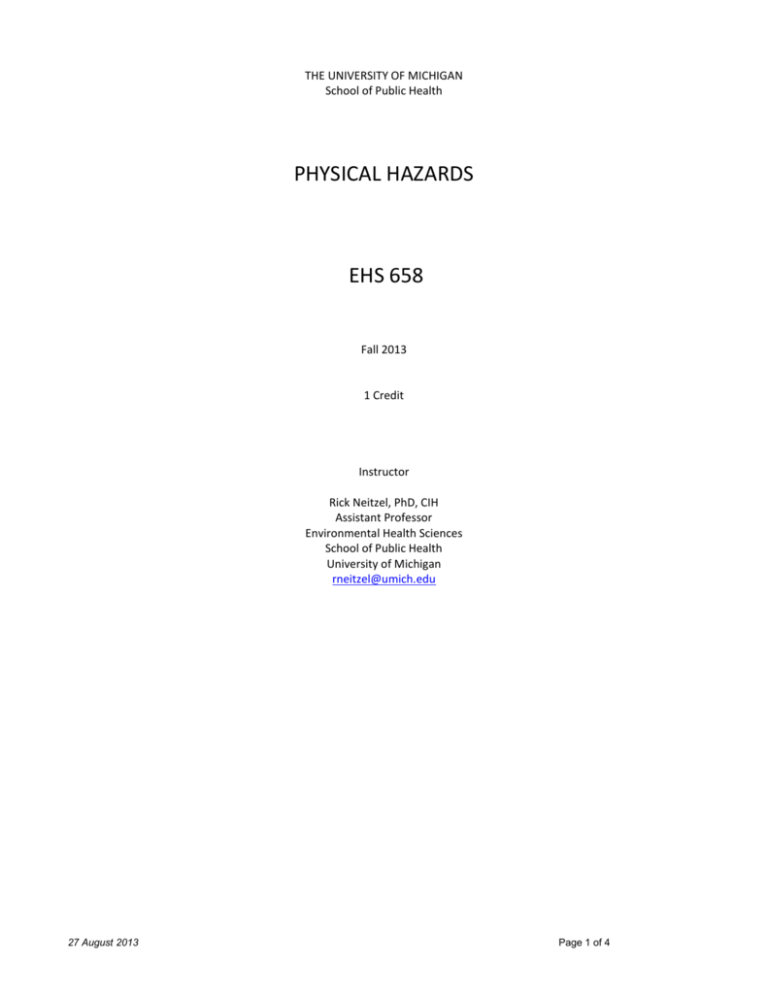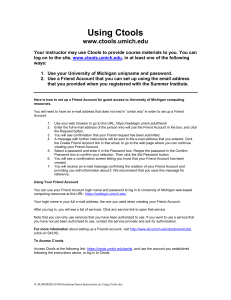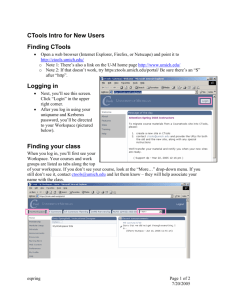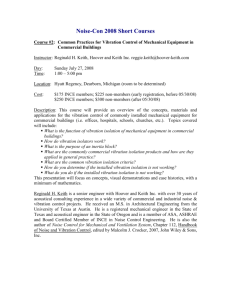EHS 658
advertisement

THE UNIVERSITY OF MICHIGAN School of Public Health PHYSICAL HAZARDS EHS 658 Fall 2013 1 Credit Instructor Rick Neitzel, PhD, CIH Assistant Professor Environmental Health Sciences School of Public Health University of Michigan rneitzel@umich.edu 27 August 2013 Page 1 of 4 Course Syllabus EHS 658: Physical Hazards Fall Term, 2013; 1 credit hour; ½ semester format Tu 3:30PM - 5:30PM 1138 SPH2 Instructor: Rick Neitzel Office: Room 6611D SPH Tower phone: 734-763-2870 email: rneitzel@umich.edu Office hours by appointment 1. Course Description This course covers a range of physical agents (with a special emphasis on noise), and discusses methods for characterizing exposures to these agents, effects of these agents on human health, and the regulations and standards which set limits for exposure to these agents. The basics of measurements and control for these agents are also introduced through hands-on exercises. At the conclusion of this course students will have gained a breadth of knowledge related to the sources, exposures, and health effects of these agents, which will allow them to better understand the public health implications of exposures to these agents. The material presented in class, and the understanding gained though completion of hands-on exercises and a laboratory report, will provide a broad perspective of the importance of physical agents in both workplace and community settings. Students will develop effective written skills in presenting and discussing their scientific findings. Prerequisites: Graduate Standing or permission of instructor 2. Course Format This course will focus on lectures and equipment demonstrations. Lively discussion is encouraged (and expected). 3. Learning Objectives In this course, we will explore various aspects of exposure to physical hazards. Throughout the course we will emphasize the application of critical thinking skills to different scientific concepts. Learning objective # Learning objective Level of knowledge Expected The students taking this class are expected to learn about: L1 Introduction to workplace and community physical hazards Intermediate L2 Familiarization with characteristics of the following specific physical agents: noise, human vibration (including whole-body and hand-arm), heat and cold stress, lasers and other non-ionizing radiation spanning the electro-magnetic spectrum from ultraviolet to radio frequency Familiarization with instruments available to measure noise, vibration, and some electromagnetic frequencies Discussion of health effects, source and exposure measurement methods, controls, and regulations and standards governing exposures to each of these specific physical agents Intermediate L3 L4 4. Intermediate Intermediate Student Competencies Competency # 27 August 2013 Competency Level of competency expected Page 2 of 4 The students that have taken this class are expected to be able to: C1 C2 C3 C4 C5 5. Assess the nature and extent of potential health hazards associated with exposure to physical hazards Identify sources of such physical hazards encountered in the workplace Intermediate Select the proper method/instrument for measuring source characteristics and worker and community exposure levels Interpret such measurements with respect to current regulatory standards Intermediate Make informed recommendations for control options to reduce exposures/hazards Intermediate Intermediate Intermediate Ctools A Ctools site is maintained for this course and can be accessed via the gateway site at https://ctools.umich.edu/portal. The schedule for the course is maintained on the Ctools site, with supplemental readings, lecture slides and handouts linked as Resources. Announcements of changes or additions to the course schedule, readings and assignments will be made in class and posted to the Ctools site. 6. Readings Readings will be drawn from the peer-reviewed primary literature and available on Ctools. It is essential to review the readings recommended on the syllabus before coming to class. 7. Performance Evaluation This class is taught at a graduate level, and regular attendance and participation in classroom discussion is required. Grading is based on: 8. Attendance (20%) Participation (20%) One lab report (20%) Two take-home quizzes (20% each, 40% total). Classroom Courtesy and Special Precautions for Flu Season Please turn off cell phones and texting devices during class and limit laptop use to course note taking. Be on time for class and return to the classroom on time after break. Finally, should you become ill, especially with flu-like symptoms, please stay at home. Contact the course instructor for information on how to catch up with course materials following your illness. 9. Academic Integrity The following is the School of Public Health statement on academic integrity (Standard of Academic Conduct, University of Michigan School of Public Health, June 2004): “The faculty of the School of Public Health believes that the conduct of a student registered or taking courses in the School should be consistent with that of a professional person. Courtesy, honesty, and respect should be shown by students toward faculty members, guest lecturers, administrative support staff, and fellow students. Similarly, students should expect faculty to treat them fairly, showing respect for their ideas and opinions, and striving to help them achieve maximum benefits from their experience in the School. Student academic misconduct refers to behavior that may include plagiarism, cheating, fabrication, falsification of records or official documents, intentional misuse of equipment or materials (including library materials), and aiding and abetting the perpetration of such acts. The preparation of reports, papers, and examinations, assigned on an individual basis, must represent each student’s own effort. Reference sources should be indicated clearly. The use 27 August 2013 Page 3 of 4 of assistance from other students or aids of any kind during a written examination, except when the use of aids such as electronic devices, books, or notes has been approved by an instructor, is a violation of the standard of academic conduct.” The standards of academic conduct and procedures for dealing with alleged violations of these standards are detailed online at the following URL: http://www.sph.umich.edu/students/handbook/rights.html Allegations of violation of this honor code and standard of academic integrity will be handled according to SPH procedures as detailed in the web site, http://www.sph.umich.edu/students/handbook/rights.html 10. Class Schedule Session/ Date 3 Sept 10 Sept 17 Sept 24 Sept 1 Oct 8 Oct 15 Oct 22 Oct 29 Oct 27 August 2013 Topic Readings Assignment Noise, part I Introduction Fundamentals of sound Mechanics of hearing Noise, part II Noise-induced hearing loss Non-auditory health effects Instrumentation Measurement Standards are guidelines Noise, part III Hearing conservation programs Sound propagation Directivity Reverberation/absorption Engineering controls -- -- May JJ. Occupational hearing loss. Am J Ind Med. 2000 Jan;37(1):112-20. -- Daniell WE, Swan SS, McDaniel MM, Camp JE, Cohen MA, Stebbins JG. Noise exposure and hearing loss prevention programmes after 20 years of regulations in the United States. Occup Environ Med. 2006 May;63(5):343-51. Epub 2006 Mar 21. TAKE HOME QUIZ 1 Noise laboratory exercise WCB-BC, Occupational Noise Surveys, 2nd Ed QUIZ 1 DUE Noise, part IV Hearing protection devices Human vibration Whole-body vibration Chapter 6: Hearing Protection Devices, CDC/NIOSH Criteria Document 98-126 (1998) Human vibration Hand-arm vibration Thermal stress Thermal stress environments Physiology and thermoregulation Standards and guidelines Exposure control Pelmear PL, Leong D. Review of occupational standards and guidelines for hand-arm (segmental) vibration syndrome (HAVS). Appl Occup Environ Hyg. 2000 Mar;15(3):291-302. Passchier-Vermeer W, Passchier WF. Noise exposure and public health. Environ Health Perspect. 2000 Mar;108 Suppl 1:123-31. -- Smith DR. Leggat, PA. Whole-body vibration: health effects, measurement and minimization. Professional Safety (2005) 50 (7) LAB REPORT DUE Keim SM, Guisto JA, Sullivan JB Jr. Environmental thermal stress. Ann Agric Environ Med. 2002;9(1):115. NO CLASS – FALL STUDY BREAK LAST DAY OF CLASS Cold stress Non-ionizing radiation Background / Principles Static (DC) Fields Extremely Low/Very Low Frequency Radio Frequency, Microwave Radiation Optical Radiation Chapter 22: Nonionizing Radiation. In: The Occupational Environment: Its Evaluation and Control, 1st ed, 1998. AIHA Press, Fairfax, VA. Pages 491-546. TAKE HOME QUIZ 2 -- -- QUIZ 2 DUE Page 4 of 4







